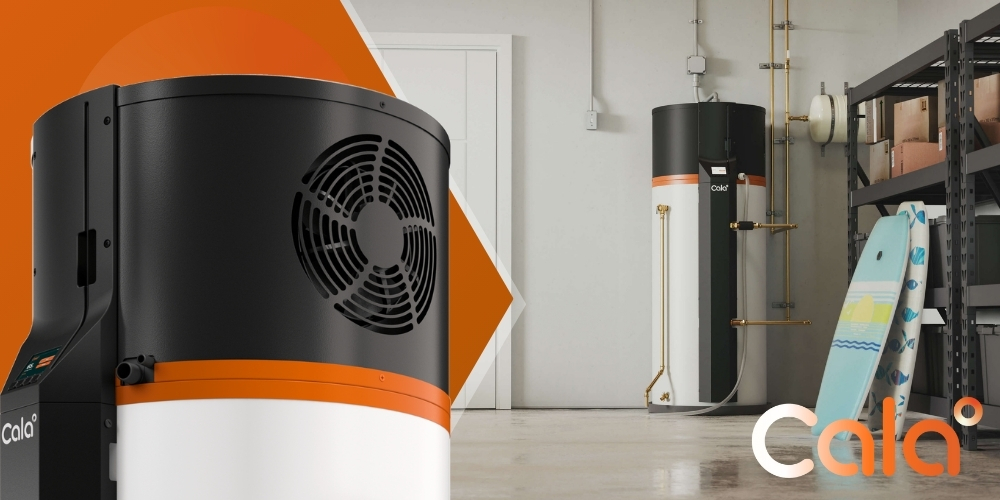Does Your Home Need Ductwork Modification or a Full Redesign?

Intelligent Heat Pump Water Heaters for Massachusetts Residential Homes — Why SumZero Selects Cala
By SumZero Energy Systems — Massachusetts’ #1 Heat Pump Installation Team
Picking a new water heater once involved a simple decision between gas and standard old electric, praying the hot water wouldn't be gone when there were two showers in a row. That's no longer the case. Now, the ideal solution for the majority of Massachusetts homes is a smart heat pump water heater (HPWH). This isn't the typical hybrid of which you might have heard, but a rather new breed of unit that adapts to your home's schedule, accommodates your energy usage, and maintains comfort consistently while consuming a lot less energy.
When homeowners want to have it exactly right the first time, our team is discerning about what products we choose. We consider the landscape and inspect the details before determining that they might work with Cala, a company that produces a high-technology hot water heater that modern homes need: intelligent, consistent, and efficient hot water — installed properly. This article describes why this alliance matters, how the tech benefits your home, what you should expect from our installation, and the handy information (rebates, credits, fit questions) homeowners inquire about daily.
Why This Alliance Is Important
(and What It Does for You)
There are two parts to a successful hot water solution:
Great technology
A system that makes you comfortable and uses less energy.
Great installation
Design, placement, airflow, electrical, condensate handling, commissioning, and long-term support.
Cala provides a tailor-built, smart HPWH platform. SumZero provides actual-world experience so that it works perfectly in real Massachusetts homes.
Together, we provide three things homeowners report wanting:
Accurate hot water at peak periods without guessing.
Cheaper monthly energy bills without compromise on comfort.
It is a future-proof solution that addresses the trend towards greener, all-electric homes.
Simply put: We get hot water. We know how to properly install heat pump technology. This combination makes a water heater upgrade a smart, long-term decision.
The Homeowner's Dilemma That We Are
If you have had a gas or a typical electric water heater, then you know the problems:
Hot-cold swings on hectic morning routines.
Higher electricity bills than hoped for.
No real insight, no real control.
A replace cycle that is experienced as "buying the same thing again."
Typical hybrid: Heat pump water heaters perform better, yet they still react: They delay until the tank cools off, then warm it up again. Homeowners averred they desire a system which thinks ahead—a unit which is a breeze to operate, handles peak load graciously, and does not make them compromise.
They fill that gap, which is why we work with them.

Why a Smart HPWH is Different
A standard electric water heater makes heat by passing an electric element, a giant toaster coil, through the tank. A heat pump water heater does it another way: it takes heat from the air it lives in and puts it into the water. Because it costs less energy to move heat than create it, heat pump water heaters run on much less power than typical electric ones. And they avoid burning gas, venting, and pollution.
A smart HPWH goes one step further:
It adapts to your home's schedule (morning showers, nighttime laundry) and preheats when demand isn't yet high.
You can use the app to check, plan, or increase hot water whenever you want.
It has a compressor that can change speed to fit what you need (not just "on/off").
It is achievable with a mixing valve holding water at the proper warmth for improved efficiency and then providing a sustained, safe warmth for usage. This is also possible with the availability of additional warm water at peak usage times.
It goes nicely with a contemporary home — primed for solar, time-of-use, and information you can view at a glance.
Result: more stable comfort, less energy use, improved control.
Why a Smart HPWH is Different
From what is visible on-site, there are three things certain for homeowners regarding the points of Cala:
1) Ease That Is Effortless
Consistent hot water at peak use is the ultimate test. Through forecasting demand and using a mixing valve, Cala maintains a steady supply. That results in less "uh oh" when two showers coincidentally happen at once or someone turns on the dishwasher.
2) Controls That You'll Ever Use
App functionality is key when done properly. You can check if there's hot water, turn up the heat for guests, view energy usage history, or simply set it and leave. As installers, we appreciate performance data — it allows us to address little issues before large ones form.
3) Future-Ready from Day One
Massachusetts is going towards clean, electricity-based homes. Cala's strategy combines well: it is scalable for solar power and accounts for time-of-use rates when needed. If you foresee solar energy at some time, or already have it, this water heater won't stop your home from being efficient.
4) A Company That Stands Behind Its Product
Cala backs every unit with a 10-year parts warranty and 3-year labor warranty — a strong sign they stand behind both the technology and the people who install it. At SumZero, we respect that kind of commitment because it mirrors our own approach: taking care of homeowners and supporting our partners with the same level of trust and accountability.
What SumZero Offers As Your Installer
(Why It Matters)
Even the best system won't work so great if installed wrong. Our task is getting your new HPWH working perfectly inside your home, not on a drawing board. This is what our approach is:
Right-size design.
We measure how much water your home needs and discuss the high-flow fixtures, filling bathtubs, and washer usage.
Best installation and ventilation.
HPWHs require air to make the heat move. We consider the room size, doors, vents, and — when necessary — ducting solutions for high performance and low noise.
Clean handling of electricity and condensate.
Safe power, tidy routing, and a trustworthy drainage plan are essential.
Commissioning correctly.
We don't just "turn it on." We verify performance, position the mixing valve, help you with the app, and verify your comfort objectives.
Rebates, credits, and financial assistance.
Mass Save, federal 25C, and the 0% HEAT Loan (if applicable) — we'll help you with that.
We take special care.
Our teams respect your home, protect your floors, and leave the place nicer than they found it.
Aftercare you can count on. Questions years down the road? We're here. The whole concept of a smart system is long-term confidence, not a one-day installation.
Costs, Incentives, and Lifetime Value
Two parts matter here: upfront cost and operating cost.
→ It is a better unit than a standard electric or simple hybrid. Tax credits and rebates make a big difference. A lot of Massachusetts homeowners rely on the 0% HEAT Loan for easier payments.
→ Month after month, the intelligent HPWH's effectiveness is where the value lies. By transferring (not creating) heat and by scheduling heating intelligently, homeowners consistently experience significant decreases in water-heating energy consumption — particularly relative to resistance electric, and many times relative to gas or delivered fuels when full costs are factors.
If you'd like figures specific to your home (household number, showering usage, energy costs), we'll do the math at your consult and provide you with a clear estimate of payback, lifetime cost saving, and the rebates for which you qualify.
Are Smarter Heat Pump Water Heaters Good for Your Home?
It is feasible for many Massachusetts homes. We will cover:
→ Household size and routines. Families with up to about 5 people usually do well with the standard setup; we will give advice for larger families or special situations.
→ Space and ventilation. We check the space, door vents, or ducts if necessary, and ventilation so the system operates properly.
→ Location. Basements are typical, as are utility rooms. As the unit functions, it removes air that feels like a dehumidifier — a typical plus for basements.
→ Electrical. We check panel capacity and proper wiring; no installation day surprises.
→ Future plans. Now or in the future for solar? Time-of-use rates? We'll put the system on so it grows with your home.
[[cta-heatpump]]
Why Is Cala Different from "Traditional Hybrids"?
✪ Control and Convenience:
Cala integrates intelligent tech with a mixing valve to remain comfortable, even when it is busy. Most standard hybrid units have simple modes and react only when the tank becomes chilled.
✪ Care and Trust:
Performance insights help you recognize problems early on and keep you on your feet for surprises. Traditional deployments are mostly "wait and see."
✪ Timing and Efficiency:
Variable driving and improved scheduling assist in energy saving with the maintenance of comfort. Ordinary hybrids operate more often and at undesirable times.
✪ Future-Ready
The design of the Cala accommodates with solar power, intelligent homes, and plans for utilizing electricity. Most older hybrids were not built for that usage.

What to Expect with SumZero
(From the First Call Through the First Shower)
✪ Talk & Pictures
We'll first glance at your objectives and take some fast photos of the current installation: the water heating unit, panel, and surrounding room.
✪ Right-Fit Design
We fit your hot water consumption and available spaces to a design which we endorse.
✪ Chaplain: A Comprehensive
Your quote is going to be transparent, includes information for installation, accessories, and a checklist for incentives. The paperwork assistance takes care of our end.
✪ Professional Installation
Licensed, insured, and detail-orientated. We dispose of the old unit, prepare the site, install and commission a new system, and leave the site tidy.
✪ App Introduction and Instructions
You'll discover how to see hot water supply, schedule increases, and view consumption — without being "technical."
✪ Support and Help
We're your long-term partner. Got a question? You call us — that's what homeowners deserve from the #1 heat pump installation company.
Common Questions We Get
(And Easy Answers)
Smart heat pump water heaters move heat from the surrounding air into the water instead of generating heat directly. This makes them up to three to four times more efficient than standard electric models. Cala’s intelligent system takes it further — it learns your household’s patterns, preheats before busy periods, and gives you app-based control to monitor or boost hot water anytime.
Most hybrid water heaters react when the tank cools. Cala predicts when your home will need hot water and heats proactively, saving more energy while maintaining comfort. It also features a variable-speed compressor, integrated mixing valve, and performance monitoring portal, giving both homeowners and installers a smarter, more reliable experience.
Savings depend on your energy source and usage, but many Massachusetts homeowners cut their water-heating costs by 50–70% when switching to a heat pump system. Cala’s intelligent controls add even greater efficiency. Add Mass Save® rebates, federal 25C tax credits, and potential 0% HEAT Loan financing, and most families see real payback within just a few years.
Yes — most Massachusetts homes are a great fit. Cala’s 65-gallon design comfortably serves households up to five people and can prepare up to 90 gallons ahead of peak use. The system needs adequate space and airflow, similar to a dehumidifier, and our team at SumZero handles every detail — from placement and ducting to electrical and performance checks.
SumZero Energy Systems is Massachusetts’ #1 heat pump installation team, trusted for precision, transparency, and high-quality service. We manage every step — design, installation, rebate paperwork, app setup, and long-term maintenance — so homeowners enjoy smarter comfort and lasting confidence. With SumZero, you’re not just buying equipment; you’re gaining a partner who stands behind it.
Why We Feel Secure Recommending This to Massachusetts Homeowners
We have a simple promise: we only install solutions that we would use in our own homes. Cala’s approach — being smart, having control, and being ready for the future — matches what we have learned from many talks with homeowners in the state. Together with SumZero’s careful installation standards and ongoing support, this water-heating upgrade makes sense right away and will last well with your home. Cleaner heat. Smarter comfort. Fewer bills.
Ready to Take the Next Step?

To learn more about Cala’s technology and vision, visit Cala Systems.
Understanding When Ductwork Needs More Than Just a Repair
Massachusetts homeowners often assume that fixing a problem with airflow or uneven room temperatures only requires a quick repair or new equipment. But in many homes—especially older properties or recent remodels—the issue isn’t the HVAC system itself, but outdated or poorly designed ducts. So how do you know whether you need minor ductwork modification services or if it's time for a full duct system redesign?
The key lies in evaluating your home's performance as a whole. Spotting signs early and understanding how ductwork affects comfort, energy efficiency, and air quality can help you make the right decision for your home and budget.
Common Symptoms That Your Duct System Isn’t Working Properly
Recognizing the early warning signs is the first step in deciding whether your ductwork needs attention.
- Hot or cold spots across rooms
- High utility bills with no clear cause
- Excessive dust or musty smells
- Loud airflow or whistling sounds
- Family members noticing increased allergy symptoms
Surprisingly, up to 30% of heated or cooled air is lost through ducts with leaks or design flaws—costing Massachusetts homeowners hundreds per year in wasted energy.
Small issues like a loose vent or minor leak may be quickly resolved. But if these problems persist even after tune-ups or equipment changes, deeper investigation is likely needed.
Factors That Call for a Full Redesign Instead of a Simple Fix
Some homes in Massachusetts were never designed with efficient airflow in mind. If your layout, insulation, or room usage has changed, your original duct system may no longer fit your needs.
Here’s when a full duct system redesign may be the better option:
- Rooms recently added or converted (e.g., attic finished or garage enclosed)
- HVAC system upgraded, but airflow hasn’t improved
- Additions block or restrict airflow paths
- Ducts run through uninsulated or damp areas like basements or crawlspaces
In such cases, simply repairing or modifying the existing ducts may not address the root problems. Instead, creating a new configuration with custom ductwork solutions can increase comfort while making your energy use more efficient.
[[cta-heatpump]]
How Ductwork Redesign Improves Comfort and Air Quality
Over time, problems with duct layout or materials can worsen, especially in homes that dealt with previous renovations. From drafty rooms to excessive dust, these symptoms add up—not just in dollars but in family comfort and health. Investing in a duct redesign isn’t just about airflow; it’s about upgrading how your home lives and feels.
Boosting Home Ventilation and Reducing Allergy Irritants
Poorly ventilated spaces in your home can trap pollutants, allergens, and moisture. Modern home ventilation strategies—like properly sized duct runs and return vents—help maintain healthy indoor air.
- Balanced supply and return in each room
- Proper filtration at key junctions
- Integration with air purifiers or dehumidifiers
- Fewer pressure imbalances between floors
Good duct design isn’t just quieter or more efficient—it can significantly improve indoor air quality by reducing mold and allergens trapped in walls and hidden ducts.
Especially in historic Massachusetts homes, original ductwork is often undersized or takes a winding path that no longer serves today’s usage patterns.
Enhancing Efficiency with HVAC Airflow Optimization
Today's efficient heating and cooling systems require balanced airflow to perform at their best. If your current ductwork isn’t optimized, your HVAC may work overtime, pushing systems harder and wearing them out faster.
Here’s how HVAC airflow optimization through redesign helps:
- Consistent temperatures room to room
- Less system cycling and noise
- Improved response to thermostat settings
- Reduced energy use and monthly costs
If you’ve installed newer systems from trusted brands like Mitsubishi Electric or Daikin and haven’t seen the expected energy savings, it could be a sign your ductwork is holding back overall performance.
Choosing The Right Ductwork Installation and Replacement Approach
Building a better duct system starts by considering how your whole home works together. Ductwork isn’t one-size-fits-all, and Massachusetts homes come in all shapes and ages. Whether you're replacing an outdated setup or planning a retrofit for an upcoming renovation, knowing your options allows you to get more out of your new investment.
What to Consider Before You Begin
If you're deciding between air duct modification or full replacement, assess these areas first:
- What's the age and condition of your existing ducts?
- Have you updated your HVAC system recently?
- Are there areas of your home that consistently stay too hot or cold?
- Has your home been remodeled or reconfigured lately?
- Are you're looking to improve indoor air quality or lower energy costs?
Knowing where your priorities lie—comfort, cost, or health—will guide your next step.
Understanding the Value of Custom Ductwork Solutions
No two homes in Massachusetts have the same duct needs. A customized installation or ventilation and duct modification plan can provide flexibility for current challenges and future updates.
- Routes ducts through properly insulated spaces
- Matches airflow to actual room size and function
- Uses modern materials for better efficiency
- Simplifies future maintenance due to improved access
- Can be designed to work with heat pumps and other renewable upgrades
Homes that undergo custom duct redesigns prior to major upgrades can see efficiency improvements of 20% or more, especially when combined with weatherization and modern equipment.
If you're planning to apply for Mass Save® rebates or energy-efficiency programs, upgraded ductwork can support eligibility and maximize long-term savings.
When to Install or Replace vs. Redesign
Sometimes a blended approach is best. Replacing sections of ductwork while reworking the overall layout can offer a balanced solution:
- Replace damaged or undersized duct lines
- Reroute branches blocking airflow
- Install new returns for better system balance
- Use dampers to control airflow to problem rooms
This allows you to improve core issues while staying within budget or project scope. Working toward a better-functioning system—without starting from scratch—is both practical and cost-effective.
Final Thoughts
Massachusetts homes present unique heating and cooling challenges due to our weather, home age, and regional building styles. But that doesn’t mean you’re stuck with discomfort, loud duct noise, or inefficient airflow.
Evaluating your system and investing in the right level of ductwork installation and replacement can improve more than just temperature—it can enhance your home's air quality, energy savings, and everyday comfort.
If your ductwork feels like the missing piece in your home’s heating and cooling puzzle, a redesign might be the path forward worth exploring.
Maximize comfort, airflow, and energy efficiency with expert ventilation and duct modification tailored for Massachusetts homes—because your HVAC system works best with ducts that truly fit your space.
Optimize Your DuctworkYou Might Also Like…
Continue learning with handpicked articles that inform and inspire.
Not Sure Where to Start? We’ll Guide You
Let our experts design the right heating and cooling solution—customized for your comfort, your layout, and your energy goals. No pressure. Just clarity.
Request FREE ESTIMATE









